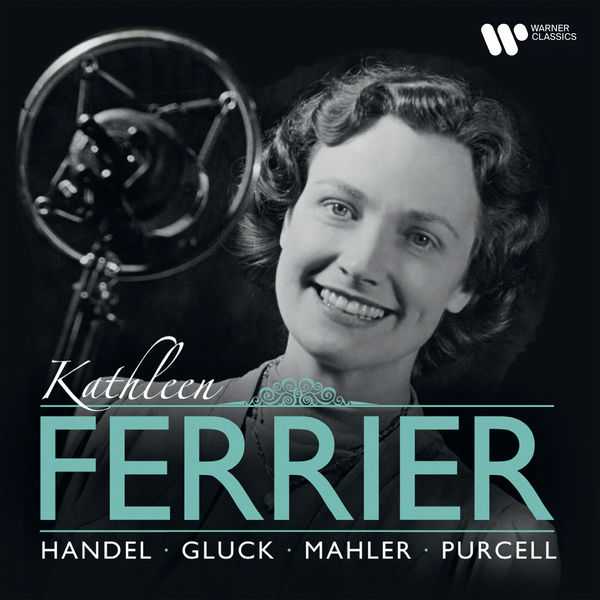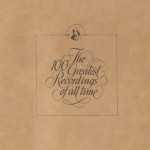
Composer: Johann Sebastian Bach, Johannes Brahms, Edward William Elgar, Christoph Willibald Gluck, Maurice Greene, George Frideric Handel, Gustav Mahler, Felix Mendelssohn, Henry Purcell
Performer: Kathleen Ferrier, Gerald Moore, Isobel Baillie, Elisabeth Schwarzkopf, Greet Koeman, Nel Duval
Orchestra: Wiener Philharmoniker, Wiener Symphoniker, Orchestra of the Netherlands Opera
Conductor: Bruno Walter, Herbert von Karajan, Charles Bruck
Number of Discs: 3
Format: FLAC (tracks)
Label: Warner
Catalogue: 9562842
Release: 2012
Size: 429 MB
Recovery: +3%
Scan: cover
CD 01
01. Gluck: Orfeo ed Euridice (1997 – Remaster): What is life to me without thee? (Che farò senza Euridice) (Act 3)
02. Brahms: 6 Lieder Op. 3 (1997 – Remaster): Constancy (Liebestreu) (Reinick)
03. Brahms: 49 Deutsche Volkslieder (1997 – Remaster): No. 12, Feinsliebchen, du sollst mir nicht barfuss geh’n
04. Elgar: The Dream of Gerontius Op. 38 (1997 – Remaster): My work is done … It is because
05. Greene: I will lay me down in peace (from anthem ‘O God of my righteousness’)
06. Greene: O praise the Lord (from anthem ‘Praise the Lord, O my soul’)
07. Handel: Spring is coming (‘Ottone’ – Haym)
08. Handel: Come to me, soothing sleep (‘Ottone’ – Haym)
09. Purcell: Sound the trumpet (‘Birthday Ode for Queen Mary’)
10. Purcell: Let us Wander not Unseen (based on music from The Indian Queen, Z630)
11. Purcell: Shepperd, shepherd, leave decoying (‘King Arthur’ – Dryden)
12. Mendelssohn: I would that my love, Op.63 No. 1 (Heine)
13. Mendelssohn: Greeting, Op.63 No. 2 (Eichendorff)
Mahler: Kindertotenlieder
14. Nun will die Sonn’ so hell aufgeh’n
15. Nun seh’ ich wohl, warum so dunkle Flammen
16. Wenn dein Mütterlein, tritt zur Tür herein
17. Oft denk’ ich, sie sind nur ausgegangen!
18. In diesem Wetter, in diesem Braus
CD 02
Bach: Mass in B minor, BWV232
01. Duet: Christe eleison
02. Contralto aria: Qui sedes
03. Duet: Et in unum Dominum
04. Contralto Aria: Agnus Dei
Gluck: Orfeo ed Euridice
05. Sinfonia
06. Ah! Se intorno a quest’urna funesta (Act I)
07. Amici, quel lamento (Act I)
08. Ballet of Shepherds and Nymphy (Act I)
09. Ah! Se intorno a quest’urna funesta (Act I)
10. Chiamo il mio ben così (Act I)
11. Voi delle ombre oscura (Act I)
12. Amore assisterà l’infelice marito! (Act I)
13. Gli sguardi trattieni (Act I)
14. Che disse? Che ascoltai? (Act I)
15. Dance of the Furies Chi mai dell’Erebo (Act II)
16. Deh! Placatevi con me (Act II)
17. Misero giovane! (Act II)
18. Mille pene, ombre sdegnose (Act II)
19. Ah! Quale incognito (Act II)
CD 03
Gluck: Orfeo ed Euridice
01. Dance of the Blessed Spirits Dance of the Heroes (Act II)
02. È quest’asile ameno e grato (Act II)
03. Che puro ciel! Che chiaro sol! (Act II)
04. Vien a’regni del riposo (Act II)
05. Ballet of the Heroes (Act II)
06. Oh voi, ombre felici (Act II)
07. Torna, o bello (Act II)
08. Ah vieni, o diletta, vien con me (Act III)
09. Vieni! Vieni con me, vieni, o cara! (Act III)
10. Ah, dovess’io saper (Act III)
11. Che fiero momento (Act III)
12. Ah, per me il duol ricomincia (Act III)
13. Che feci mai? (Act III)
14. Che farò senza Euridice? (Act III)
15. Ah! Finisca e per sempre (Act III)
16. Non più! che fai tu? (Act III)
17. Gaudio, gaudio son al cuore (Act III)
18. Trionfi Amore! (Act III)
Mahler: Kindertotenlieder
18. Nun will die Sonn’ so hell aufgeh’n
20. In diesem Wetter, in diesem Braus
Issued to mark the centenary of Kathleen Ferrier’s birth, this 3CD set brings together for the first time all the EMI recordings by this great contralto, including two previously unissued tracks. In addition the booklet features three EMI publicity photos rarely seen since she first signed a contract with HMV/Colombia in 1944
Kathleen Ferrier (22 April 1912–8 October 1953) remains one of the best-loved British singers of our time. The eminent vocal expert Alan Blyth wrote of her in 1998: ‘Kathleen Ferrier, a legend in her own lifetime, has certainly become one since her untimely death in 1953. Her professional life, lasting little more than a decade, saw her rise from the obscurity of appearing with choirs in the north of England to the eminence of an international career in the company of such conductors as Barbirolli, Walter and Klemperer. It was an extraordinary transformation in every respect, but one wholly justified by the dignity and conviction of her singing and the commitment of her interpretations.’
CD1 begins with four test recordings of pieces by Gluck, Brahms and Elgar recorded by producer Walter Legge in June 1944 but not issued until 1978. Ferrier signed a one-year contract with EMI in September 1944 and her first commercial release was the two arias by the Baroque composer Maurice Greene that follow. Then come two Handel solos and five duets with soprano Isobel Baillie of compositions by Purcell and Mendelssohn. These completed Ferrier’s EMI contract and she then moved to Decca.
In 1949 Ferrier came back to EMI to record Mahler’s Kindertotenlieder in London with the Vienna Philharmonic Orchestra conducted by Bruno Walter, the great Mahlerian who had introduced Ferrier to this work, which closes CD1
CD2 begins with four items recorded at a rehearsal in June 1950 for a concert of the Bach Mass in B Minor in Vienna with the Vienna Symphony Orchestra conducted by Karajan. EMI was setting up its recording equipment in the Musikvereinssaal for another project while the rehearsal was taking place and the engineer, as a test, turned on the tape machine to capture, almost complete, these four precious Ferrier tracks, which include two solos and two duets with the soprano Elisabeth Schwarzkopf.
Then comes a complete performance of Ferrier’s signature operatic role, that of Orfeo in Orfeo ed Euridice by Gluck. This live recording dates from a radio broadcast in July 1951 in Amsterdam.
CD3 concludes with two bonus tracks; these are reserve takes of the first and the fifth movements of Kindertotenlieder being issued here for the first time. This work was originally recorded on 12-inch waxes, with a tape machine running as safety back-up, as was EMI’s practice in 1949. Masters from the waxes were used for most of the original 78-rpm sides, but for the release of the work on CD, the back-up tapes were used, and these reserve ‘takes’ have also survived.



